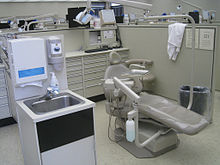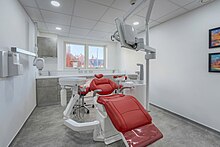|
Dental engine
  A dental engine is a large chair-side appliance (often including the dental chair itself) for use in a dentist's office. American dentist Josiah Flagg created the first adjustable dental chair in the late 18th century, adapting a wooden chair by adding an instrument tray on one side, as well as a movable headrest. This equipment was continually improved, and in the 20th century[when?] became an integrated treatment unit, incorporating air, water, gas, and electricity into one piece of equipment. At this point,[when?] patients were treated sitting, with dentists standing. In 1958 John Naughton created a chair with an articulated seat and back, which marked the introduction of what is called "four-handed dentistry". At minimum, a dental chair serves as a source of mechanical or pneumatic power for one or more handpieces. Typically, it will also include a small faucet and a spit-sink, which the patient can use for rinsing, as well as one or more suction hoses, and a compressed air/irrigation water nozzle for blowing or washing debris clear of the work area in the patient's mouth. The equipment possibly includes an ultrasonic cleaning appliance, as well as a small table to hold the instrument tray, a operating light, and possibly a computer monitor or display. LED operating lights have transformed the user experience in recent years providing a 'cool' light, with a bulb that doesn't need changing and which floods the oral cavity with a light distribution that reduces shadows, and in turn eye strain. A light with a high color rendering index accurately reflects colour for soft and hard tissue diagnosis; some lights also have a useful composite mode, which illuminates without curing photo-initiated resins. Due to their design and use, dental chairs are a potential source of infection from several kinds of bacteria, including Legionella pneumophila.[1] Gallery
References
|


